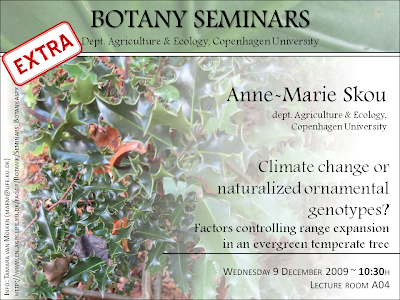
Natural and human caused shifts in dominant vegetation in sub-arctic Greenland in relation to climate changes
Rasmus Jørgesen
dept. Agriculture & Ecology, Copenhagen University
Arctic ecosystems are seen as particularly susceptible to climate change due to their adaptation to cold conditions. Climate change is expected to be strongest in polar regions. In contrast to this, southern Greenland has experienced a 2 degree cooling during the last 50 years. Nevertheless, prognoses for the climate in southern Greenland predict temperature increases for the next 100 years.
In most subarctic regions, shrubs are expanding in range and dominance. This tendency is thought to originate from human-caused climate change and/or an increase in temperature since the Little Ice Age. For South Greenland, it is not known if shrub abundance has changed.
Alnus viridis sp. (green alder) is among the species that have shown the most pronounced expansion rates in NW America with large ecosystem consequences. It is not known what forces connect higher temperatures with increased shrub abundance. Until now, green alder has had a limited range in Greenland – outside the potentially climatologically optimal area. Increased temperatures can have beneficial effects for the species range and dominance in Greenland.
In southern Greenland, the interest for establishing tree plantations with introduced species is increasing. Plans for large-scale plantings are taking form. Increased temperatures and shrub abundance (especially alder) are forces that could facilitate tree growth following afforestation in southern Greenland.
Rasmus Jørgesen
dept. Agriculture & Ecology, Copenhagen University
Arctic ecosystems are seen as particularly susceptible to climate change due to their adaptation to cold conditions. Climate change is expected to be strongest in polar regions. In contrast to this, southern Greenland has experienced a 2 degree cooling during the last 50 years. Nevertheless, prognoses for the climate in southern Greenland predict temperature increases for the next 100 years.
In most subarctic regions, shrubs are expanding in range and dominance. This tendency is thought to originate from human-caused climate change and/or an increase in temperature since the Little Ice Age. For South Greenland, it is not known if shrub abundance has changed.
Alnus viridis sp. (green alder) is among the species that have shown the most pronounced expansion rates in NW America with large ecosystem consequences. It is not known what forces connect higher temperatures with increased shrub abundance. Until now, green alder has had a limited range in Greenland – outside the potentially climatologically optimal area. Increased temperatures can have beneficial effects for the species range and dominance in Greenland.
In southern Greenland, the interest for establishing tree plantations with introduced species is increasing. Plans for large-scale plantings are taking form. Increased temperatures and shrub abundance (especially alder) are forces that could facilitate tree growth following afforestation in southern Greenland.

